Vol. 1, No. 45
Table of Contents
Assist Feeding – Cat Milk
Feline Nutrition – Good Question!
Pro-Active Cat Care – “Cat With Two Tales”
Kitty Potpourri – Breed Profile: The Persian Cat!
Assist Feeding – Cat Milk
by Kathy Fatheree
The only foods that I have come across that are thin enough right out of the can to syringe are Hill’s a/d® and the Eukanuba Nutritional Recovery Formula®. All other foods have to be thinned down. Many people will tell you just to thin it down with water, but I disagree. A kitty that is needing to be assist fed is a kitty that is more than likely needing as many calories as you can possibly get down him or her. Assist Feeding is not always the easiest thing to do, and quite often, kitty does not get enough nutrition. The average cat of 10 pounds needs about 275 calories per day. The Hill’s a/d food has 180 calories in one can (5.5 ounce can / 156 gram can). So if your cat weighs 10 pounds, you probably need to feed him or her a little more than 1 and ½ cans per day. If you are having trouble just getting 1 can in per day, thinning the food with water that has 0 calories will only lessen the nutrition your cat is receiving.
Instead of using water, consider using one of the many new “cat milk” products. They are not high-calorie, but they are higher than water AND they contain balanced vitamin and minerals that cats need. Many are lactose free so you don’t have to worry about upsetting kitty’s stomach.
One example of cat milk is a product called Healthy Essentials Milk Treat. This company actually has 3 different varieties:
- White Cheddar Flavor with approximately 19 calories per 1 oz. serving
- Original Creamy Flavor approximately 18 calories per 1 oz. serving
- Senior Lite & Creamy Formula Flavor Milk approximately 14 calories per 1 oz. serving
Other brands are:
LapHappy(TM)
Whiskas® CATMILK Plus
KMR Milk Replacement for Kittens (and “adult cats needing extra nutrients”)
Take a trip to your local pet store and start reading labels!
NOTE: Be sure to talk to your vet before adding any of these products to your cat’s food. Your cat may have special nutritional requirements that will prohibit the use of these products.
Feline Nutrition – Good Question!
by Garry White
“Why isn’t my cat eating?” How many of us have asked this question? Probably most of us, at one time or another. A cat’s eating habits will change for a variety of reasons: The change can be gradual, or it may happen overnight; the change can be minor, or Fluffy may lose interest in food altogether. We’ll examine a few reasons why this might occur, but first let’s establish a ground rule: It’s serious to Fluffy, so it needs to be serious to us, as well. Whatever the cause, we need to find it and fix it.
Stress: Unlike humans who head for the chocolates during stressful periods, cats head for the darkest corner. Kitties are affected by the most obscure events; events that we consider normal: Relocation is a sure bet to upset them; introduction of a new pet into the household, new furniture (and sometimes just rearranging a room!). A new baby with all those new, squawky sounds.
People: Cats, as we all know, have the enviable ability to sort out the wheat from the chaff. They do not like all people, and generally its people who do not like them first. When this conflict-of-chemistry exists between a cat and a person, the cat will simply hide, and eat only when that person is absent.
Food: Food has to appeal to a cat, or they won’t eat it. Period. Which includes aroma first, then temperature, texture, taste, and even presentation; sometimes just changing the size or shape of a serving dish will make a difference!
Clinical: Fluffy has been a good eater until recently. No babies here, no new dogs, cats, or even alligators in residence. We haven’t moved, still the same raggedy furniture, and mean ol’ Uncle Henry died last April. We need to consider possible medical reasons, which means a trip to the vet. Something is amiss, and if it’s not obvious then we need to look deeper.
Age: I’m an exception: Old as I am, I can still pack away a 28-ounce Porterhouse (medium rare, please). But I’m not a cat. With cats, appetite wanes with age, for a couple of reasons. First is simple metabolic displacement.the metabolism has decreased, they aren’t as active as they used to be, ergo, they simply don’t need as much food as they used to. Secondly, as organs age, performance and functionality diminishes; the digestive system of an older cat is simply unable to process the bulk of earlier years.
These are just a few of the reasons why a kitty’s eating habits might change. The list is long, and we must always, always be alert, watching for signs that our attention is needed. The whole business of maintaining Fluffy’s wellness is a juggling act, but know beyond doubt that the center ball is proper nutrition.
ProActive Cat Care – “Cat With Two Tales”
by Garry White
We all know I wear several hats when discussing the topsy-turvy world of veterinary medicine but, in sum, it boils down to these two conclusions:
- We need those vets; that much is inarguable.
- BUT.We need to manage our cat’s wellness, and not rely solely and blindly upon what a vet tells us must be done.
Today, I saw evidence to support both sides of this controversy. Today, I was blessed with the privilege of witnessing, first hand, that not all clinical recommendations are created equal. I share the following scenarios with you, in hopes that you’ll take it as I did.a lesson in reality.
My Clarkie, as you know, had an abscessed tooth. A previous article explained that the first vet we saw wanted to established a situation that would have been extremely intrusive and stressful to Clark, and probably more dangerous than beneficial. So I pulled the plug on that scene. Enter Vet #2, whom I stumbled onto quite by accident while staging an appointment for Dear Wilbur. Concerning Clark’s problem, New Vet says: “Try antibiotics for a few days; sometimes that’ll save the tooth, and thus the need for surgery. But even if the tooth has to come out, he needs pre-treatment antibiotics anyway.” Well, the tooth was simply too far gone and did have to come out, and today was the big day. I took Clark to New Vet this morning, prepared for the iffy business of surgery under anesthesia. As I’m holding Clark in my arms, New Vet pokes the gums a few times, wiggles the tooth a little bit, then grabs hold of the tooth with an odd looking device. One yank, one yelp from Clark, and the tooth (including rotted root) are no longer a part of his anatomy. Doc smiles. I set Clark on the floor; he shakes his head twice and wanders off to inspect Doc’s office, totally unconcerned. I had been in the building less than five minutes. This, dear friends, is an example of a vet who does what’s best for the cat, not what’s best for the bottom line. He, like the previous chap, could have dragged this into an expensive, complicated (and risky!) nightmare for Clark, and I wouldn’t have been qualified to challenge him. But rather than expose an older cat to the rigors of anesthesia and surgery, he took the path of common sense. In return for his good wisdom, Clarkie boy suffered nothing more than an instantaneous pinch, and it was completely done and over with in seconds; no stress.no time for stress! Same cat, same loose tooth: One vet with an agenda based on something other than Clark’s welfare; the other vet simply wanted to get that tooth out with the least amount of stress and/or risk to the cat.
What I saw today fortifies what I encourage all of you to practice: Be in charge of what’s going on! Let common sense guide you, and when you feel it’s wrong walk away! You’ll hear more about this new vet and his humanitarian-based operations in coming weeks. I plan to get involved with them as time and circumstance permit, and I plan to get you involved, too.so b
Kitty Potpourri – Breed Profile: The Persian Cat!
by Dan Malenski
This week we will discuss the Persian breed that is currently the number one breed in popularity. As I write this sentence, I am getting a stern look from the girls who maintain that the Domestic House Cat is the most popular breed, but then they accuse me of splitting hairs (fur?) when I state that we are only referring to purebred cats.
Regardless, we all agree that they are all beautiful and we love ’em all! There is an abundance of information about the Persian from many sources, but we obtained most of the information for this article from the Cat Fanciers Association web site.
The Persian was given its name based on the belief that they originated from Persia and Iran, but research had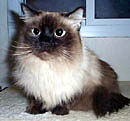 failed to pinpoint their precise beginnings. The hallmarks of the breed are their long coats, pansy-like faces, large captivating eyes, and gentle personalities that can adapt to a wide variety of living arrangements. They are medium to large size cats with short heavily boned legs, but appear to be much larger with their long fur coats. They do prefer households on the quieter side, but with the proper amount of attention, will also get along well in active households.
failed to pinpoint their precise beginnings. The hallmarks of the breed are their long coats, pansy-like faces, large captivating eyes, and gentle personalities that can adapt to a wide variety of living arrangements. They are medium to large size cats with short heavily boned legs, but appear to be much larger with their long fur coats. They do prefer households on the quieter side, but with the proper amount of attention, will also get along well in active households.
For those looking for a low maintenance cat, the Persian cat would not be suitable. Their long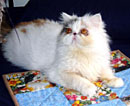 coats are highly prone to matting and must be brushed daily with a metal comb to prevent the formation of mats. An occasional bath is also in order in addition to a daily face wash, as their large eyes will produce a greater amount of tearing than the average cat. All of the above is in addition to the care that is given to all other cat breeds and keeping it indoors to keep it free of disease and parasites.
coats are highly prone to matting and must be brushed daily with a metal comb to prevent the formation of mats. An occasional bath is also in order in addition to a daily face wash, as their large eyes will produce a greater amount of tearing than the average cat. All of the above is in addition to the care that is given to all other cat breeds and keeping it indoors to keep it free of disease and parasites.
The number of colors that that the Persians come in is so large that they have been divided up into several color divisions,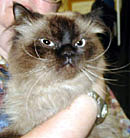 that is the Solid, Silver and Golden, Shaded and Smoke, Tabby, Particolor, Bicolor, and Himalayan. Needless to say, any discussion of each color division will require so much space, that I may invoke the wrath of the internet police; therefore we will only list them. Note that the “Himalayan” is a color division and is not a separate breed, as many folks seem to think; in other words, the Himalayan is a Persian of a particular color group.
that is the Solid, Silver and Golden, Shaded and Smoke, Tabby, Particolor, Bicolor, and Himalayan. Needless to say, any discussion of each color division will require so much space, that I may invoke the wrath of the internet police; therefore we will only list them. Note that the “Himalayan” is a color division and is not a separate breed, as many folks seem to think; in other words, the Himalayan is a Persian of a particular color group.
The Persians are generally hardy and healthy cats, but they are susceptible to polycystic kidneys (PKD) that will lead to chronic renal failure, so those folks who must obtain one from a breeder should insure that the breeder is a professional who pays absolute attention to the bloodlines in order to eliminate this genetic defect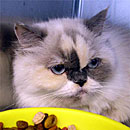 in their litters. Melissa advises that the breeder who merely screens their cats should be avoided, as the thought of merely screening brings the following question to the surface, “what happens to the cats who have polycystic kidneys?” Amanda also suggests that this could be another reason to adopt a Persian from a shelter in addition to providing a home for a cat looking for someone to love.
in their litters. Melissa advises that the breeder who merely screens their cats should be avoided, as the thought of merely screening brings the following question to the surface, “what happens to the cats who have polycystic kidneys?” Amanda also suggests that this could be another reason to adopt a Persian from a shelter in addition to providing a home for a cat looking for someone to love.
Due to the popularity of the breed, you will find a huge selection of purebred Persians and Persian mixes to choose from in the shelters and rescue organizations around the nation. Therefore, we will not feature any particular shelter cat(s) here as we had done in the past, but will implore you to consider a shelter the first place you will look for a Per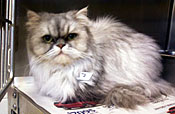 sian companion. It was Amanda’s idea to tell you at this time that none of the cats pictured in this article are show cats or from breeder web sites, but waiting in shelters for someone to embrace.
sian companion. It was Amanda’s idea to tell you at this time that none of the cats pictured in this article are show cats or from breeder web sites, but waiting in shelters for someone to embrace.
Click here to find a Persian Cat!
Disclaimer: Kathy Fatheree is not at all a medical expert. Contents of this web site are a collection of Kathy’s assist feeding experiences as well as the experiences of other cat owners who have assist fed their cats. While every effort has been made to ensure the accuracy of the information, Kathy Fatheree or anyone associated with this web site cannot be held responsible for anything that may happen as a result of using the information on this site.
